Spaces devoid of windows or openings allowing natural air circulation and cooling are nothing unusual. Basements converted into condos, dressing rooms tucked out in some sultry corners in the house, and other spaces enclosed by walls can be hard to ventilate.
But this doesn’t mean these drab spaces can’t be converted into well-lit and ventilated areas. In this guide, let’s talk about how you can use different kinds of AC units to ventilate your dingy space and turn it into a cool joint.
At a Glance: Our Top Picks for AC Units for Rooms with No Windows
- BEST MINISPLIT SYSTEM: Cooper & Hunter CH-12SPH-230VI/O-WK
- TOP EVAPORATIVE COOLER: Honeywell CL201AE
- BEST PORTABLE AC (VENTED): Black+Decker BPACT14HWT
Comparison of the Best AC Units for Rooms with No Windows
| IMAGE | PRODUCT | |
|---|---|---|
 |
| View Latest Price → |
 |
| View Latest Price → |
 |
| View Latest Price → |
 |
| View Latest Price → |
 |
| View Latest Price → |
What Makes a Windowless AC Worth Buying?
There are several features of portable air conditioners that make them worth buying. Of course, it depends on the type you get and the functions available. In general, here are some of the top benefits.
Easy to Install
Most windowless ACs are available for use straight out the box. If they have water buckets, you can almost instantly plug them in and begin cooling your room. Remember, you’ll need to empty the tray as soon as it’s full or the air conditioner will switch off as a safety mechanism.
Excellent Portability
Portable units are easy to move around your home. You can decide which room needs it the most or where you’ll be spending the majority of your time.
This aspect makes it ideal for spot cooling, specifically if there’s an area in your house that suffers from heat the most. In most cases, you can merely unplug it from one socket and plug it in a different one elsewhere.
Removes Foul Odors
When you’re staying in a room with no windows, foul odors have limited space to escape. Air conditioners sometimes have internal filters to help remove these, making your living area smell clean and fresh.
Exceptional Cooling
If you buy the right size, the windowless AC will assist in maintaining a comfortable room temperature. It helps when you can’t crack open a window for a light breeze, especially if the device has fans for ventilation.
Cost-Effective Solution
Portable air conditioners are more affordable than most window counterparts. Since there are fewer components involved, most of the direct and indirect costs are lower. These include purchasing, maintenance, and electrical expenses.
Of course, some varieties cost more than others that depend on several factors.
If you’re aiming at specialized gadgets or functions, you’ll end up paying more. The same applies to portable ACs that have drainage hoses, where you’ll need to pay to put a small hole in your wall.
Unique Features
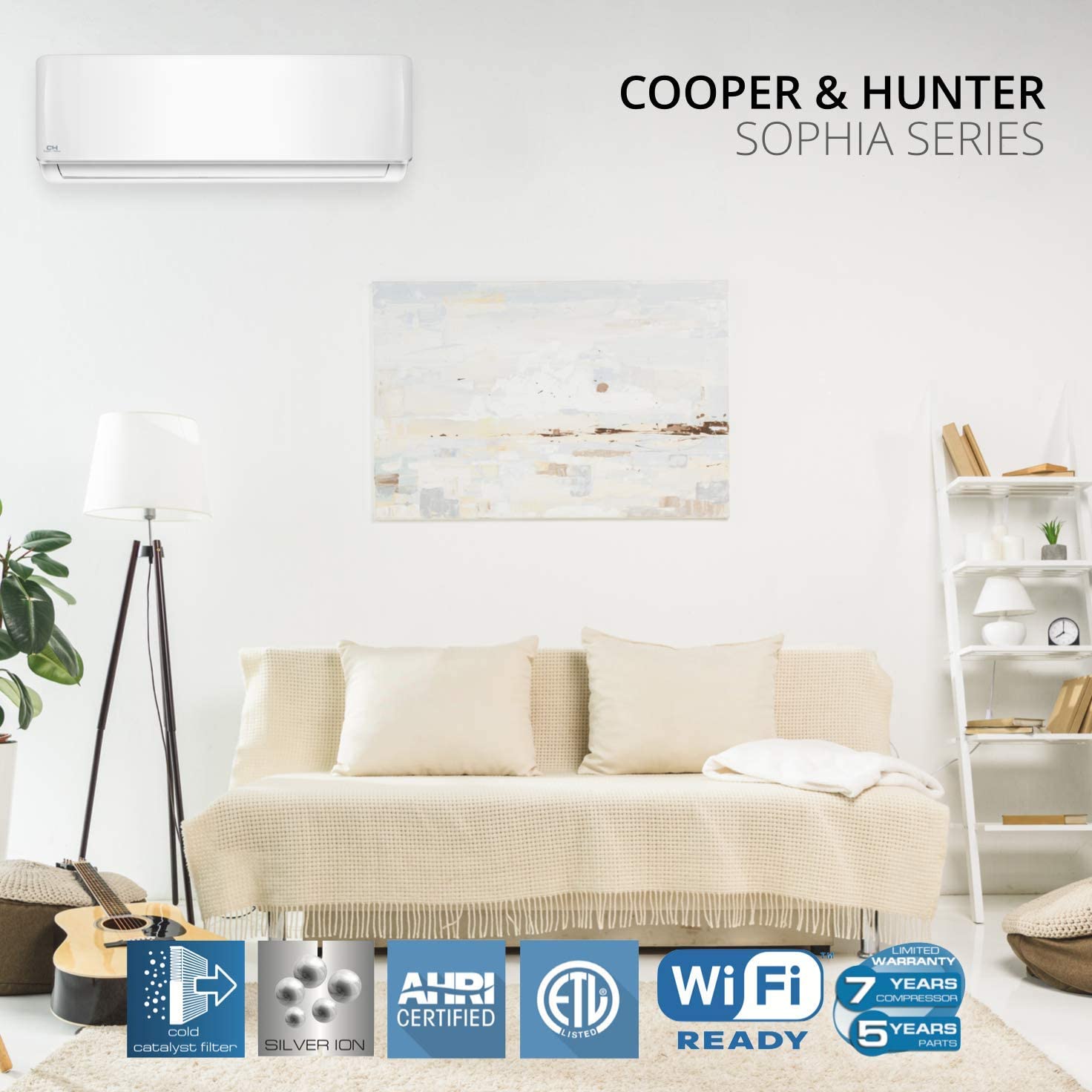
Cooper & Hunter CH-12SPH-230VI/O-WK
Speaking of gadgets, there are a few functions that can make your life easier. You can opt for voice and app control instead of a remote, making the device even more convenient. Also, you may find other modes included, such as purification, dehumidification, and ventilation.
If you enjoy a quiet night’s sleep, ensure that you look out for ones that include a night mode with silent performance. Others include a small night light if you prefer not to sleep in the dark.
Review of the Best AC Units For Rooms With No Windows
Often times, rooms that have no windows are also compact in size. This means that whatever the cooling system you are to settle for, it should fit into the available space. And it shouldn’t be noisy and should basically work without the need for constant monitoring.
Fortunately, you do not need to fabricate your own custom-made cooling system. There are already numerous and very efficient hybrid systems designed to operate in poorly ventilated and compact spaces. Here are four such systems to choose from:
Minisplit System
This is a ductless AC designed to sap air from the outside and hence cooling down the room. A mini-split air conditioner is a hybrid structure consisting of a window unit, a central air unit and a condenser. During installation, the condenser is placed outside and then connected to an evaporator placed high up inside the room. The merits of sourcing for a Minisplit system are:
- The outdoor components make the system compact enough to fit into small spaces such as small basements and dressing rooms. The indoor evaporator can also be placed in any appropriate point inside the room. Thus it won’t stand in the way of items such as furniture or lighting components.
- Since the condenser, which is the noisier part of the system, sits outside the room, the whole system is generally quiet. It makes this cooling system ideal for rooms such as a man cave or a dressing room. Or a relaxation joint where silence is of utmost importance.
- The system is flexible and can be zoned so that you only cool individual rooms when the need arises.
Best Minisplit System:
Cooper & Hunter CH-12SPH-230VI/O-WK

PROS
CONS
Specs
Dimensions: 45” x 40” x 40”
Cooling Capacity: 12,000 BTU
Weight: 120 lbs
Control Type: remote and app
Type: Ductless mini split
Review
What makes this air conditioner an excellent option for rooms with no windows is that you’ll receive heating and cooling modes. You won’t need to buy a separate heater to warm your space, while you’ll enjoy the silent performance while you sleep.
While the package consists of high-quality installation kits and an insulated copper line set, you may find it challenging to install if you’ve never done it before. You can expect to call on someone to help you, especially with the heavy condenser.
Should the parts or compressor fail, there are generous warranty periods as long as you don’t mess around with the components. The purchase also includes a lift-gate service for when you need to maintain it.
Bottom Line
This ductless mini split air conditioner is ideal if you don’t plan on moving the device around in the near future. You can cool your room in the summer and heat it in the winter, giving you the best of both worlds.
While it may be heavy to install, you’ll hopefully only need to do it once. There’s also a handy app you can use on your phone to control it via Wi-Fi if you don’t feel like hunting for the remote.
Evaporative Air Cooler
If you live in a low-humidity area, the evaporative air coolers can provide a cost-effective way to cool your house. Evaporative air coolers work on the principle of evaporation. By accelerating the natural heat exchange process.
Basically, the system has a pump that draws water from a reservoir and delivers it to cooling pads on the back part of the cooler. Filter pads placed at the back of the system suck in the warm, dry air in the room. And force it to flow over the damp pads causing the water to evaporate. The evaporation cools the hot air thus making your space more hospitable.
Why Install an Evaporative Air Cooler in Your Room
- An evaporative air cooler operates smoothly and quietly. You can thus install it in basically any type of space, be it your dressing area, bedroom, or your favorite relaxation area in the basement.
- The whole unit costs much less compared to some other ventilating systems. As it is free standing and doesn’t come with an exhaust vent hose. Compared to some other power-hungry cooling systems, the non-motorized swamp air cooler only needs water to chill your space. This lowers operational and maintenance costs.
- Evaporative air coolers are also ventless meaning that you won’t need to alter the room. Or make ugly holes on the walls to vent the system to the outside. This means you can install it with ease and start using it right away.
Top Evaporative Cooler:
Honeywell CL201AE

Portable Air Conditioner
Portable air conditioners tower over the crowd. They are extra efficacious, produce little noise during their operation and can double up as a dehumidifier and a fan. You’ll find these energy-efficient cooling units easy to move around the house. And this makes them suitable for apartments where other central AC units may not fit. So, how do you benefit by opting for a portable air conditioner?
- Can comfortably cool a large space
- The unit is programmable to suit your needs
- Specialized filters clean up the air
- The dual hose leads to efficient performance
- Eco-friendly
Best Portable AC (Vented):
Black+Decker BPACT14HWT

Through-The-Wall Unit
Through-the-wall AC units offer a more permanent cooling solution as they emit the heat from the exterior part of the home’s walls. These self-contained cooling units come with wall sleeves that secure the unit on the walls. Through-the-wall units are versatile enough for installation on any space.
Best Through-The-Wall AC:
LG LT1016CER

- Has a 9,800 BTUs capacity and cools up to 450 sq. Ft of room space
- 3 fan speeds to choose from
- EER (energy efficiency Ratio) of 10.6
- Fitted with a Mesh filter to clean the air
Honorable Mention:
Pioneer Wall Mount Ductless Inverter+ Mini Split Heat Pump
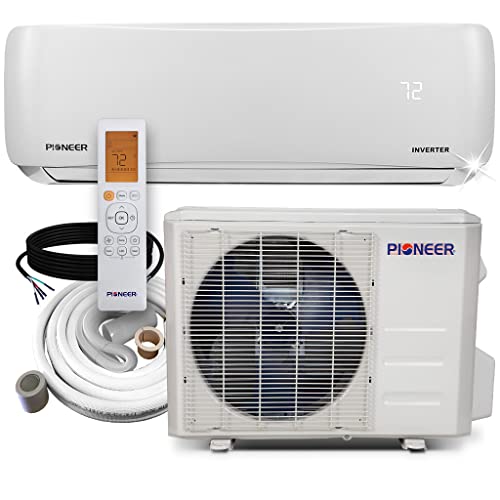
Comparison Between Window AC Units and Through-The-Wall Units
Through-the-wall units mainly vent from the rear section minimizing possibilities of warm air re-entering the room. Window AC Units vent the heat from both the rear parts and the sides.
Window AC units are easily portable. Thus can be brought in only when the need arises. Through-the-wall units are a rather permanent fixation.
Window AC units can only be fitted on the windows and, as such, you must get measurements right during the purchasing processes. Also, a poorly fitting Window AC unit may lead to leakages and inefficiencies. Through-the-walls are conveniently fixed on holes, made to specifically fit the unit.
There are different ways to cool and refresh a room lacking windows. The kind of system to install in a room depends on a variety of factors. Including space available, portability, associated costs, and humidity of the environment.
The units herein have a wide application, and can certainly fit into any space. Or adapt to any existing climatic condition. Check out what fits your space and enjoy the convenience of having a cooled space in the midst of searing heat.
The Challenges of Cooling a Room Without Windows
Poorly ventilated rooms have poor air circulation. It makes them hot, damp and even stuffy. Likewise, the humid air inside the room will clog your AC´s condensate drain unit making it overwork, overheat and eventually break down. Ultimately, you incur high maintenance costs that could otherwise be avoided by using a customized cooling unit.
What Size of AC Unit Do I Need?
The size of an AC is usually measured in terms of BTUs. And the size of your model largely depends on the area you are looking to cool with that air conditioner. If you keep this one factor in mind, then you will automatically get better efficiency and lower costs.
If the room is too big, then the AC unit will not cool properly, and if the room is too small, then the AC will cool too soon without properly reducing humidity.
Usually, it is smart to get 20 additional BTUs for every extra sq. ft. in your space.
Area (sq. ft.) | Capacity (BTU) |
|---|---|
150 - 250 | 6,000 |
300 - 350 | 8,000 |
400 - 450 | 10,000 |
450 - 550 | 12,000 |
Advantages and Disadvantages of a Windowless AC
Windowless air conditioners aren’t for everyone, and you might be disappointed in your choice. There are some pros and cons to installing one in your room, each of which you should weigh before making a decision.
Ideal for Apartments
Most landlords don’t permit window air conditioner installations, as it may damage the property. In these situations, you can easily use a portable device with a water tray. It non-intrusive and you don’t need to put vents through walls or openings.
Prevents Dampness and Mold
When your room has no windows or natural light, it’s prone to dampness and mold, especially in high humidity. Some windowless ACs have a dehumidification function to help lower these levels, keeping your space from any such risks.
Easy to Conceal
It’s impossible to hide a window air conditioner, as it stands out like a sore thumb. You can tuck portable devices neatly in a corner or hang a mini split on the wall in a way that it’s hardly noticeable. Of course, if you buy a fancy one, you’ll want everyone to see it.
May Produce Too Much Noise
The problem with windowless ACs is that many of them produce high noise levels on the fastest settings. They’re working extra hard to cool your room, which means the internal fans or compressor will hum loudly. Some manufacturers install sound dampeners, though.
Drainage Options
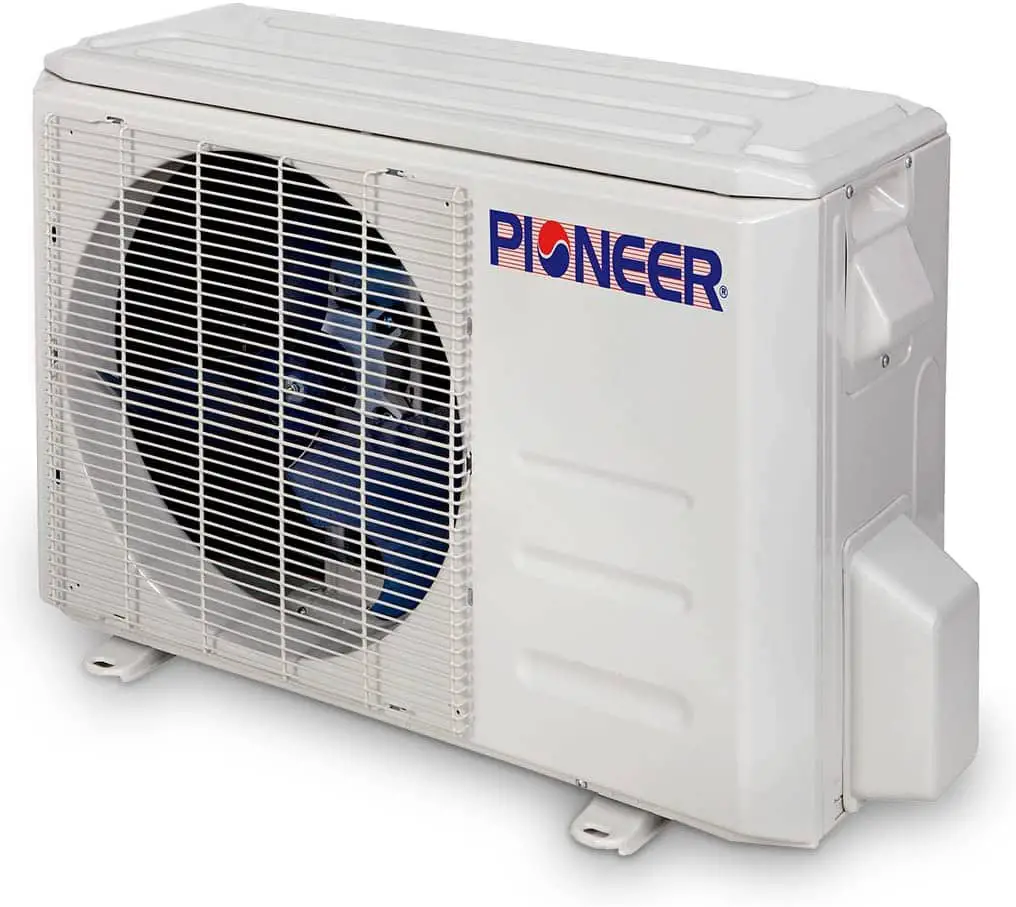


Pioneer WYS012-17
Another drawback is that many portable and mini split devices require some form of drainage for condensation. These usually lead outside or into a drain, but you may need to craft some vents to make this possible.
Your other option is an evaporative cooler, but the exhaust vent needs to go somewhere outside your room. While ACs with water buckets are another solution, you still need to empty the tank regularly.
Common Issues When Using a Windowless AC
Many problems may arise when you own a windowless AC. Some of these are common issues that you can check and quickly fix if you know the solution. Here are a few tips on what you could do to fix it.
Not Cooling Enough
There could be many reasons as to why the air conditioner isn’t cooling your room enough. The number one cause could be that it’s too small for your room size. Always measure the area and ensure that you get the correct BTU.
Another reason is that it needs maintenance. The coils may be dirty or the refrigerant old, while some dust may be trapped in any internal filters. Make sure you do routine cleaning and assessments so that it can function effectively.
Finally, the device might not be able to handle the temperature. Each air conditioner has a range it can manage, and your one might not be coping with the excessive heat. Adding a fan to help with circulation may help the situation.
Device Won’t Start
This may seem obvious, but your air conditioner may be lacking enough power to operate properly. Check your wall socket and circuit breaker to ensure that there’s electricity connected to your device. If you suspect the AC may be faulty, you might need to have a qualified electrician assess it.
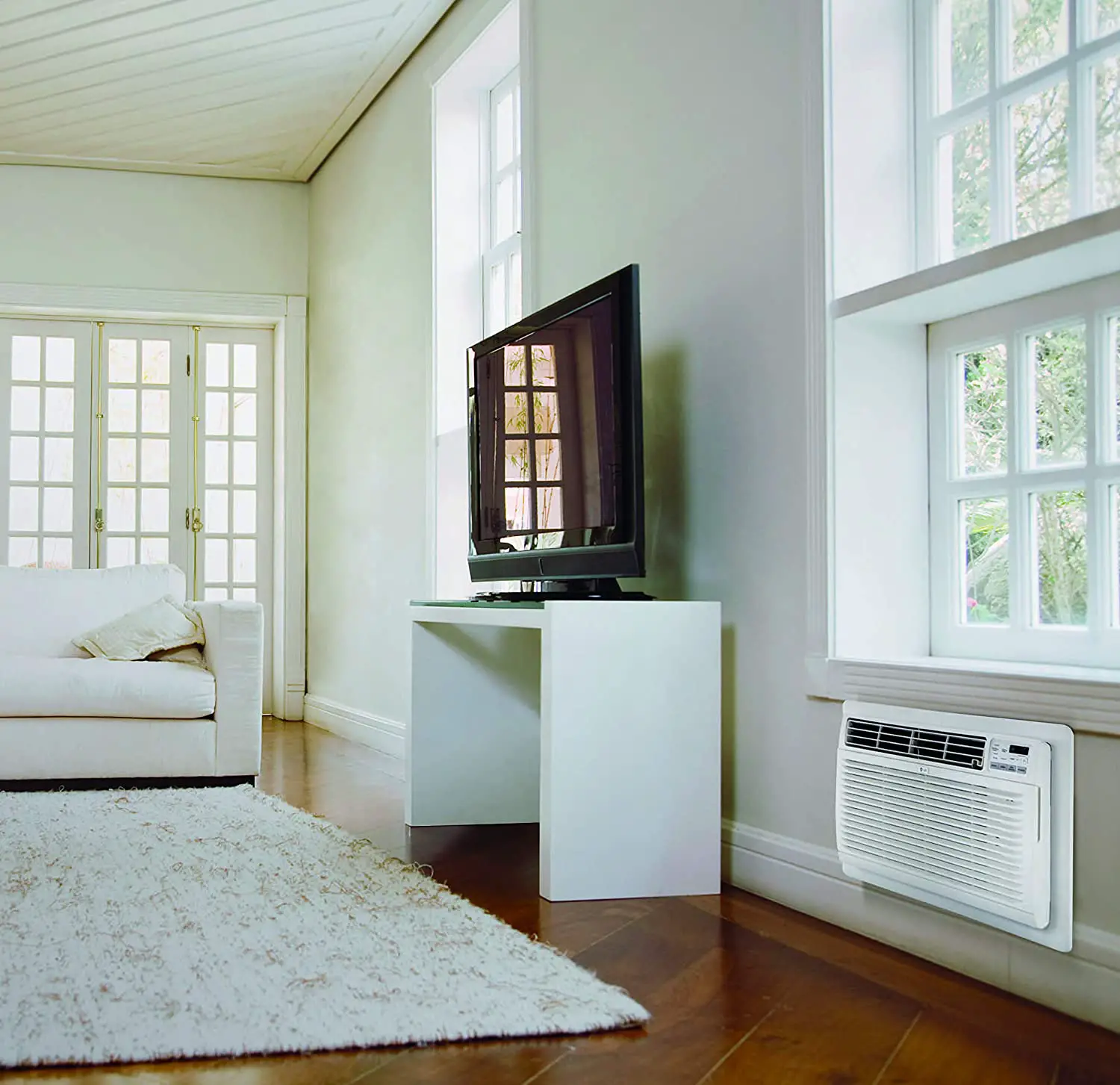


LG LT1016CER
Switches Off Randomly
There may be specific settings that cause your windowless AC to switch off. For instance, if the room’s ambient temperature is lower than the one set on the device, it’ll turn off to prevent overcooling.
Furthermore, the water bucket may be full, or you’ve accidentally turned on the timer mode.
No Air Is Coming Out
The most common reason for this issue is a blocked vent or filter. After unplugging the device, check to see if there’s any debris or large dust particles stuck inside. You should also look if any frost has collected on the coils or if the compressor has perhaps overheated.
Conclusion
You no longer need to worry about living in a room with no windows. With some of the best options mentioned above, you can say farewell to hot, damp, or stuffy air. These various hybrid systems will deliver you a peaceful and comfortable closed space without any problems.
People Also Ask
Buying a closed-space air conditioner can be a tricky business and a little risky. So, you must have a bunch of queries about it. We tried our very best to answer as many queries as we could. Take a good read and satisfy your curiosity.
How to Drain Water From a Windowless Air Conditioner
If you own a windowless AC with a water tray, you can simply remove the bucket and empty it in the basin or outside in your garden. Some have drainage pipes, though. In these cases, you can leave the hose in an external bucket or create a vent through your wall.
Who Would Benefit From a Windowless Portable AC?
People that would benefit from windowless ACs either live in a room with no windows, rent an apartment with strict rules, or enjoy natural light.
Window devices also produce noise when rattling on the frame, so you could opt for a mini split with silent performance for a good night’s sleep. If you love camping in tents, battery-powered devices are also excellent options.
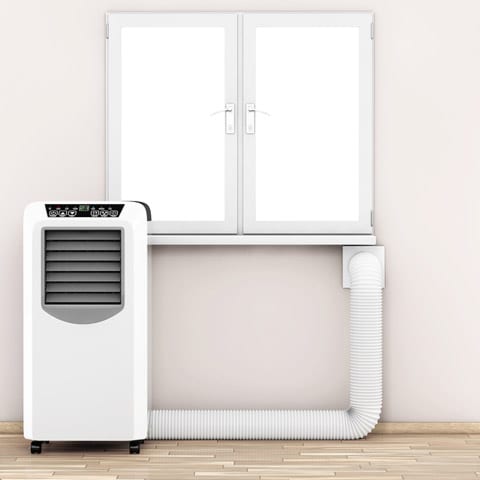


Photo credit: homeairguides.com
How to Vent a Portable Air Conditioner With No Windows
Without a window, you can vent your portable unit through either a dryer vent, a wall, or a drop-ceiling. You can use all or any of these options to efficiently and effectively ventilate your room and portable AC with no problems.
Do All Portable Air Conditioners Have to Be Vented Out a Window?
Portable air conditioners need to be vented out as they always draw hot air like every other air conditioner. If you want the space to be cooled efficiently by your unit, you need to allow hot air flow outwards. You can do it through any of the above methods.
Are Portable Air Conditioners Effective?
Portable air conditioning units will never be nearly as efficient as central units, but they can still be trusted to keep the indoor temperature at 78 degrees F, the widely recognized temperature we feel comfortable at, or under if feasible.
